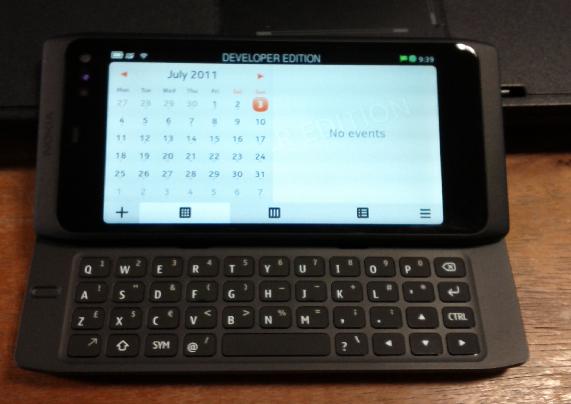Nokia N950
(→N9/950 differences) |
|||
| Line 55: | Line 55: | ||
| - | Due to the use of different display technologies, on the N9, developers should avoid one pixel with fonts and graphical objects with lines one pixel wide. Also avoid the extensive use of bright colors, especially white, when developing for OLED displays as this increases the power consumption (typical for OLED displays). | + | Due to the use of different display technologies, on the N9, developers should avoid one pixel with fonts and graphical objects with lines one pixel wide. Also avoid the extensive use of bright colors, especially white, when developing for OLED displays as this increases the power consumption (typical for OLED displays). See [http://en.wikipedia.org/wiki/PenTile_Matrix_Family this page on common OLED pixel arrangements for more info] |
| - | + | ||
==Features== | ==Features== | ||
Revision as of 00:43, 24 June 2011
This is a quick outline of a page, as I'm filling it in. The N950 is the second Maemo device which can be used as a phone. It is only available to developers, and not as a consumer product. It shares much hardware with the N9, with the notable differences that the display is TFT, not OLED, and there is a hardware keyboard.
Contents |
Hardware
N9/950 differences
Template:Fixme:Make into nice table of differences
| Feature | N950 | N9 |
| Size | Larger, Aluminium case. | Smaller, Polycarbonate one-part case. |
| Input devices | Slide-out keyboard | Touchscreen only |
| Display (854*480) | 4" TFT | 3.9" AMOLED |
| Camera | 8MP | 8MP Carl Zeiss |
| Front Camera (identical) | Top right | Bottom Right |
| Bluetooth | 2.1+EDR | 4 |
| NFC | No | Yes |
| Compass and Accelerometer | Less Sensitive | More Sensitive |
| Battery | 1320mAh | 1450mAh |
Due to the use of different display technologies, on the N9, developers should avoid one pixel with fonts and graphical objects with lines one pixel wide. Also avoid the extensive use of bright colors, especially white, when developing for OLED displays as this increases the power consumption (typical for OLED displays). See this page on common OLED pixel arrangements for more info
Features
Accelerometer
Compass
Battery
Front Camera
The N950 has a front-facing camera in the top right corner of the display.
Main camera
| Feature | Capability |
|---|---|
| Capture Resolutions | 8MP |
| Flash | |
| Lens | |
| Physical Features | |
| Sensor | |
| Zoom | |
Camera Application
| Feature | Capability |
|---|---|
| Capture Modes | |
| Exposure Options | |
| Flash Mode | |
Camera Video
| Feature | Capability |
|---|---|
| Features | 4X digital video zoom, autofocus, enable/disable microphone |
| Video Formats | MPEG-4 Video |
| Video Modes | Automatic Video, Night Video |
| Video Resolutions | WVGA: 848x480 (16:9) @ 25 fps, VGA: 640x480 (4:3) @ 25 fps, QVGA: 320x240 (4:3) @ 25 fps |
| White Balance | Automatic, Sunny, Cloudy, Tungsten, Fluorescent |
Connectivity
| Feature | Capability |
|---|---|
| Audio/Video Out | Nokia AV 3.5 mm inc. TV Out (included cable CA-75U) |
| Bluetooth | |
| GSM | Quad-band EDGE 850/900/1800/1900 |
| GPS | A-GPS, GPS receiver, Network Positioning |
| Infra Red Port | Community support of CIR from Irrecco project |
| WCDMA | 900/1700/2100 MHz, Tmobile 2100 Mhz, U.S only |
| Micro USB | (USB host mode in development) USB 2.0, USB Mass Storage, USB Charging |
| WiFi | 802.11 b/g :WEP, WPA, WPA2 (AES/TKIP), UPnP, DLNA Certification |
Memory
Main article: N900 filesystem
| Feature | Capability |
|---|---|
| Application memory | 1.93 GB see the page on using /opt for applications |
| Expandable memory | Micro SD slot for up-to 16 GB additional |
| Internal storage | Maximum built in user storage 32 GB |
| System memory | 512MB |
Detailed Hardware information
Main article: N900 Hardware Subsystems
Further reading
See also the following articles

